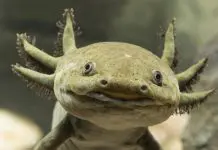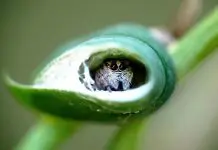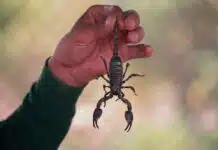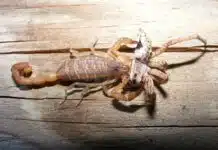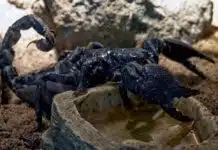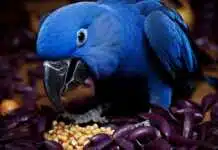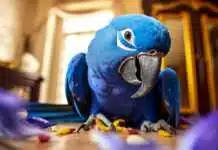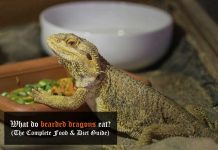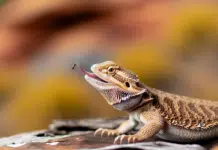When it comes to owning an exotic pet, sooner or later, snakes are sure to come up on the list. And the mighty ball pythons would undoubtedly be the most favorite snake type among the pet lovers, well, at least in the US. Among all the breeds, the Axanthic ball pythons are by far the best variety.
There are several reasons for the owners to love this breed. They are typically calm natured, manageable in size, and, of course, majestic looking. The Axanthic morph is often considered as one of the most popular designer morphs, mainly due to their unique physical appearances.
But there are a lot of interesting facts the new owners often overlook. Before you rush towards a decision, you should dig a bit deeper.
You must have a lot of questions that must be bothering like – how many morphs are available, how do they look like, what are their habits, and so on.
So, here we are, with a detailed guide that would help you make a better decision.
First Things First, What Is an Axanthic Ball Python?
An Axanthic ball python is a special type of morph that possesses a unique appearance. In Greek, the word “Axanthic” means something that lacks the color yellow.
That means an Axanthic ball python lacks the yellow color pigmentation. While most of the common ball pythons are brown or yellowish color, they tend to be black, grey, and/or white.
They are certainly rare, but as the morph is a base morph, you can actually find them in the wild. They weren’t developed in lab condition if you are wondering about the origin story of this morph. Although they are extremely rare, and this is what makes them so desirable and often expensive.
Especially, the Stormtrooper Axanthic ball pythons have a hefty price tag. You might have to spend about $50,000 bucks to get your hands on one of them. Maybe that’s why many breeders focus on the Axanthic snake only.
What Causes a Ball Python to Be Axanthic?
You already know the meaning of Axanthic and how it affects the color patterns of a ball python. But what makes a ball python to be Axanthic?
To find the answer to that question, you will have to take a look into genetics. Yes, it’s study time!
You should know that the color pigmentation of an animal depends on the genome structure of it.
If a python is green, maybe it got that trait from its mother or father. In the language of genetics, it has a gene that decided its color to be green. But the genes always work in pairs – one coming from mother and another coming from the father.
There are three kinds of genes in the play –
- Dominant
- Recessive
- Co-dominant
Dominant Genes (Aa, Ab, Ba, or Bb)
The dominant gene, as the name suggests, typically plays the lead role. Typically, the dominant gene decides, which will be a prominent characteristic in an animal. For example, if an animal has a dominant green gene and blue recessive gene in the gene-pair, it would show green color.
Recessive Genes (aa or bb)
Then comes the recessive genes. These genes don’t get expressed as there are overpowered by the dominant gene in the gene-pair. However, if there are two recessive genes in a gene-pair, the animal will demonstrate the trait of the recessive gene. As you can imagine, it is a rare scenario for an animal to have two recessive genes (homozygous) in its gene-pair.
Co-Dominant Genes (AA or BB)
Lastly, there are co-dominant genes. These genes cannot overpower the other gene in the pair but don’t get dormant either. Rather, the animal tends to express both of the traits coming from both of the genes in the pair.
Okay, that was all the back story you needed to know.
The Axanthic genes are recessive genes. That means, for an animal to be Axanthic, there have to be two Axanthic genes in the gene-pair that decides the color pigmentation. It is the same as the albinism gene. If an animal is an albino, it has to have two albino recessive genes in the gene-pair.
That’s why Axanthic ball pythons are so rare in the wild, thus making it expensive.
What Colors Do the Basic Axanthic Ball Python Morphs Have?
By definition, you must have some idea about how does an Axanthic ball python look like – they lack yellow.
Commonly, an Axanthic ball python would be black, white, or a combination of them. Grey and silver are two other dominant color varieties you can find.
Most of the Axanthic ball pythons are strikingly black, white, or grey in the beginning phase of their lives. However, with time, they tend to lose their high contrasts difference and brown out.
In this article, you will see the phrase brown out quite a few times. When the pale or the white part of the skin color of the snake slowly turns brownish, it is typically referred to as browning out. Almost all the Axanthics brown out with the passage of time, and a lot of pet owner would sell their snake when this occurs. So, you should take a look the snake very carefully, if you see a great looking Axanthic morph at a ridiculously low price point.
If you think an Axanthic ball python can only be black, white or grey, you are a bit wrong, there Axanthics that can have a red hue, a light tan, or maybe snowy white.
The color of the variation of the Axanthics also depends on other factors. For example, like a lot of morphs of other animals, they are also a few different “lines” of the ball python.
Popular Lines of Axanthic Ball Pythons: What Does It Mean?
You must have seen tags like VPI, Snake Keeper, Jolliff, etc. while searching for Axanthic ball pythons. If you are new in the scenario, the tags should confuse you. These tags refer to the line of the python.
Does the answer help you? If not, allow me to further explain.
VPI or others are actually breeders. But they are different from the common breeders. They are breeders who “found” a particular Axanthic morph. So, created a line.
Moreover, they are more trustworthy compared to any typical breeders. So, in a sense, that tag (VPI, Snake Keeper, Jolliff, Marcus Jayne, etc.) are “brands” of the breeders whom you could trust.
Among all the lines, VPI is the most popular one as they have more collection compared to other lines. However, you shouldn’t consider the other lines to be inferior. They are also great breeders. You can’t call anyone better than the others; a VPI Axanthic ball python is almost same as other Axanthic ball pythons.
One last tip, if you are planning to breed the ball pythons, you cannot cross a snake from one line to another. Breeding is only possible intra-line.
Differences Between Axanthic Ball Pythons and Regular Ball Pythons
No, the only difference between a ball python Axanthic with its normal counterpart is that they have unique color pigmentation. Other than that, every characteristic is identical.
Check the comparison between an Axanthic morph and a regular morph –
| Characteristics | Axanthic | Regular |
| Color | Black, white, and/or grey base color | Brown, dark brown, golden |
| Skin patterns | Black patterns all over the body (except albino) | Black patterns all over the body |
| Size | Males 3 – 3.5 feet, females 4 – 4.5 feet | Males 3 – 3.5 feet, females 4 – 4.5 feet |
| Life expectancy | About 40 years | About 40 years |
| Food habit | Mainly rodents and birds | Mainly rodents and birds |
| Nature of Mating | Oviparous | Oviparous |
As you can see, there is no other difference apart from the pigmentation between an Axanthic and a regular ball python. The ball python normal has dominant genes, whereas Axanthics have recessive genes to determine the color pigmentation.
Different Morphs of Axanthic Ball Pythons
The breeders have created a variety of lucrative designer morphs to appeal the eager buyers over time. Yes, these morphs are quite expensive, but they are worth the price as they look exotic and hypnotic at the same time! These are the reasons why people are so into the Axanthic ball pythons.
Let’s check out some of the crown jewels of Axanthic morphs that people get super stoked over.
| Morph Name | Identifying Color Trait |
| Black Axanthic Ball Python | Mostly black |
| Red Axanthic Ball Python | Has a tannish body with a red hue |
| Super Pastel Axanthic Ball Python | Black and white python with some greyish shade in between |
| Axanthic Clown Ball Python | Has a very dark, dorsal stripes all over the body |
| Stormtrooper Ball Python | Striking black and white combination |
| Axanthic Albino Ball Python | Albino, doesn’t have any black or dark color but can have a yellow base |
I know you want to know more about these designer morphs rather than getting a glimpse of their identifying color traits.
Don’t worry, the following descriptions have all the information you would need to know details about these morphs.
Black Axanthic Ball Python
You might think that this one is a basic and old morph, but it’s not. The world saw the first of the black Axanthics back in 2008, and all credit goes to a breeder named Tracy Barker.
This morph is almost entirely black. While the common Axanthic morphs have white or greyish shade, it doesn’t have any. You can observe very faint white lines all over the body if you have a sharp eye.
Sadly, it didn’t get much attention until a few years ago. Maybe, the reason is that the morph is relatively newer. However, pure black morphs are picking up quite some attention in the last few years.
The best thing about this morph is that they don’t brown out over the years or lose color like a lot of other popular morphs. You might find a Black Ball Python for sale at a very low price.
Red Axanthic Ball Python
The Red Axanthics are quite different from any other Axanthic morphs. The basic trait of an Axanthic morph is that it doesn’t have any yellow or red pigmentation and that’s why it doesn’t have the common brown color.
However, the Red Axanthic is an exception to the rule. It has a tanned looked sometimes have reddish hue in their base color.
Despite being an Axanthic morph, it has co-dominant genes in its gene-pair rather than a homogenous recessive pair. Due to being so unique in nature, people sometimes refer to it as a super morph.
There is another unique trait of this morph. None of the other morphs have a pure black pattern in the back. Even the black Axanthics have a dark pattern, not pitch black. Well, you can see a pure black pattern in its body. Sometimes, people call it the het red Axanthic ball python.
Super Pastel Axanthic Ball Python
Are you familiar with pastel colors? The pastel colors can smudge out quite easily giving a painting a brushy or smudgy look. You can witness similar things in this morph.
When a Super Pastel morph is born, it has almost pure white and black base with white colors gently blushing through the dark black patterns. It is as if a painter painted the python with pastel color, making artsy smudging here and there.
However, this morph is a victim of the “fading out” or “browning out” the most among all others. It might lose the desirable high contrast between the pure white and black over time. However, in no way you can call this morph to be less beautiful in any way.
Axanthic Clown Ball Python
This morph doesn’t have different colors from a regular Axanthic morph but has different patterns. You can identify them by check the dorsal stripes in its body. It even has fewer patterns in its body compared to other morphs.
Do the unique color stripes in his body give him the name “clown?”
No, actually!
The founding Axanthic Clown Ball Python had dots underneath its eyes almost looking like a real-life clown. That’s where the name originated. But those dots aren’t found in all the other members of this morph. So, don’t get confused.
Storm Trooper Ball Python
This is by far the most popular and most desirable Axanthic ball python. The irony is that a Stormtrooper Ball Python is not exactly Axanthic!
So, why did I enlist its name among the Axanthics?
As I have said, this is the most popular morph right now. It has crisp black and white contrast all over the body. Such striking contrast is even unseen among the true Axanthics.
The sharp color combination gives the morph an uncanny similarity with the famous stormtroopers from the Star Wars. It is even sometimes called Star Wars Ball Python!
There is another distinctive difference between a true Axanthic and a Stormtrooper, it doesn’t have any grey tone or shade in its body. It’s just pure white and pure black.
Such rare beauty comes with a hefty price tag that makes a lot of breeders fascinated with this breed. The first Stormtrooper Ball Python for sale was priced at a staggering $50,000!
However, there is a tragic side of the ball python stormtrooper’s story that might make a bit disappointed! As it ages, the crispy contrast in its body tends to brown out! It becomes a bit smudgy. Think of a fountain pen’s ink getting sprayed over a wet paper.
So, if you think about it, Stormtrooper snake’s aging is like the reverse process of aging of Super Patel.
No matter what, Stormtrooper python is still king of all the Axanthic morphs being most desirable morph.
Axanthic Albino Ball Pythons
Upon the first look, one might think the Albino Ball Python to be sick or unhealthy. Actually, that’s not the truth. They just have a very rare color pigmentation. Some confuse them with the Snows, the rarest morph in history.
One could only wish it to be snow ball pythons, but it’s not!
However, Albinos are quite useful if you are a breeder. If you can breed two of the Albinos together, you have about 6.25% chance to get a Snow ball python as offspring! Plus, it is the only way to breed the perfect pure-white Snow morph.
An Albino could have yellow, pink, or dark patterns all over the body.
Piebald Axanthic Ball Pythons
The Piebald morphs can be said to be a funky one! Imagine a ball python that has a Snow morph in the head part and Black morph in the tail part. Wouldn’t it look very cool?
Piebald Axanthic Ball Pythons are exactly that!
It doesn’t have affixed color combination as it is dependent on the creativity of the breeder. Piebald morphs are basically a combination of two different morphs in one snake. They are rare, unique, and, of course, darn expensive!
How Expensive Can an Axanthic Ball Python Be?
There is no definite answer to this question. It all depends on morph rarity. The more exotic looking a ball python, this expensive it would be.
If a morph browns out over time, the price will not be that much. You can even get ball pythons for sale cheap, just for $50 or so in many second-hand stores. We strongly urge you not to get one from these shops! They are often sick and can carry diseases.
A genuine, high-quality morph would have a price tag of about a couple of hundred dollars. Moreover, the females are pricier than the males as they are more valuable to the breeders. A rare female can easily be priced at a thousand dollars or more. Again, the price depends on the morph type.
Currently, the most expensive ones are the Clown. The price of the pastel clown ball python can easily hike up to $10,000 and more!
How Can you Breed Axanthic Ball Pythons?
When you are thinking of breeding Axanthic ball pythons, there is only one thing that you will have to make sure. What is that? You will have to mate two ball pythons that have recessive genes.
So, both of the mating snakes have to be homozygous with recessive Axanthic genes. Otherwise, your breeding plan will not be full-proof!
Once you manage to get two Axanthic ball pythons of different snakes, you are ready to go. Follow the step-by-step guide to breed –
- Create a suitable mating environment where you can control the temperature.
- During the winter season, drop the temperature to 10 degrees Celsius to create a pseudo winter season inside.
- Slowly increase the temperature from March
- Feed the mating partners so that they have enough energy for the mating rituals
- Let the male and the female meet in an intimate environment and don’t disturb them, every day for one hour.
- If they don’t show interest, introduce another Axanthic male. It would provoke the male for mating.
- Let them have “dates” every day until they mate.
- Check the female for signs of being pregnant.
Once the female is pregnant, patiently wait. Don’t forget to take care of the mother so that she gets all the nutrients during her pregnancy. It takes about 55 days on average for the laid eggs to hatch. Follow typical egg hatching norms like creating an incubator in the time being.
That’s it, you should get healthy Axanthic ball pythons if you follow these rules carefully.

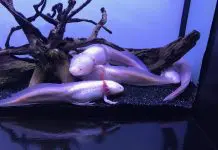

![Sick Axolotl, Fungus, Stress Symptoms [Axolotl Illness Guide 2025] Axolotl fungus](https://exopetguides.com/wp-content/uploads/2018/06/axolotl-218x150.jpg.webp)
